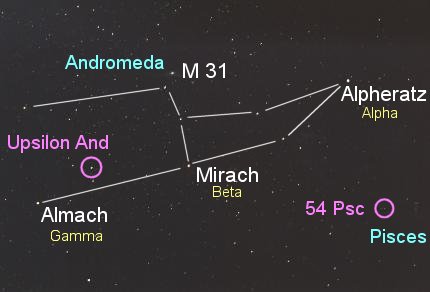 54 Piscium hosts a low mass body, measured at only two-thirds the
mass of Saturn, in an elliptical orbit that takes it close to its
cool, low-mass star. Remarkably, the system also contains a
distant brown dwarf, a substar
whose mass is too low to run hydrogen fusion, showing that a large
range of binary systems can posses planets.
54 Piscium hosts a low mass body, measured at only two-thirds the
mass of Saturn, in an elliptical orbit that takes it close to its
cool, low-mass star. Remarkably, the system also contains a
distant brown dwarf, a substar
whose mass is too low to run hydrogen fusion, showing that a large
range of binary systems can posses planets.
THE PLANET
The circle at lower right shows the location of the class K dwarf
star 54 Piscium relative to stars of Andromeda, which is depicted here. Though technically
in Pisces, the star is just barely over
the formal border between the two constellations. 54 Piscium is
the star to the right of the pair within the circle, the one at the
exact center. The one to the left is 55 Psc, a class K giant or
supergiant with an F dwarf companion that is irrelevant here. 54
Psc's planet has a mass measured to at 0.2 times that of Jupiter,
which is only 2/3 that of Saturn and one of the lower known, though
since the orbital tilt is not determined, the mass is a lower limit
and could be significantly higher. The planet orbits its star with
a period of 62.23 days at an average distance of 0.284 Astronomical
Units (42.6 million kilometers, 26.5 million miles), or 73 percent
of the distance of Mercury from the Sun. A high orbital
eccentricity takes the planet between 0.46 and 0.11 AU from its
star, making it a "hot Saturn" -- if in fact the mass is really
that low.
|
 54 Piscium hosts a low mass body, measured at only two-thirds the
mass of Saturn, in an elliptical orbit that takes it close to its
cool, low-mass star. Remarkably, the system also contains a
distant brown dwarf, a substar
whose mass is too low to run hydrogen fusion, showing that a large
range of binary systems can posses planets.
54 Piscium hosts a low mass body, measured at only two-thirds the
mass of Saturn, in an elliptical orbit that takes it close to its
cool, low-mass star. Remarkably, the system also contains a
distant brown dwarf, a substar
whose mass is too low to run hydrogen fusion, showing that a large
range of binary systems can posses planets.